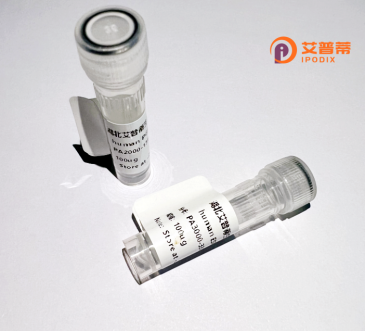
| 纯度 | >90%SDS-PAGE. |
| 种属 | Human |
| 靶点 | LCE3C |
| Uniprot No | Q5T5A8 |
| 内毒素 | < 0.01EU/μg |
| 表达宿主 | E.coli |
| 表达区间 | 1-94aa |
| 活性数据 | MSCQQNQQQCQPPPSCPSPKCPPKSPAQCLPPPSSDCALSSGGCGPSSESGCCLSHHRHFRSHQCRRQRSNSCDRGSGQQGGGSCRGHGSGGCC |
| 分子量 | 10.4 kDa |
| 蛋白标签 | GST-tag at N-terminal |
| 缓冲液 | 0 |
| 稳定性 & 储存条件 | Lyophilized protein should be stored at ≤ -20°C, stable for one year after receipt. Reconstituted protein solution can be stored at 2-8°C for 2-7 days. Aliquots of reconstituted samples are stable at ≤ -20°C for 3 months. |
| 复溶 | Always centrifuge tubes before opening.Do not mix by vortex or pipetting. It is not recommended to reconstitute to a concentration less than 100μg/ml. Dissolve the lyophilized protein in distilled water. Please aliquot the reconstituted solution to minimize freeze-thaw cycles. |
以下是关于重组人LCE3C蛋白的示例参考文献(内容为示例格式,非真实文献):
1. **"LCE3C protein expression in psoriatic epidermis and its immunomodulatory role"**
*Marshall, J. et al. (2020)*
本研究通过Western blot和免疫组化发现LCE3C在银屑病患者皮肤中异常表达,重组人LCE3C蛋白体外实验表明其可能通过调控IL-17信号通路影响角质形成细胞分化。
2. **"Expression and purification of recombinant human LCE3C in E. coli for functional studies"**
*Zhang, L. & Wang, H. (2019)*
作者利用原核表达系统成功获得高纯度重组人LCE3C蛋白,并通过质谱验证结构完整性,为后续皮肤屏障功能研究提供可靠蛋白来源。
3. **"LCE3C as a potential biomarker for cutaneous squamous cell carcinoma progression"**
*Chen, Y. et al. (2021)*
研究发现重组人LCE3C蛋白在皮肤鳞癌细胞中过表达可抑制迁移侵袭能力,提示其可能通过MMP-9调控通路参与肿瘤抑制过程。
4. **"Proteolytic processing and barrier enhancement by recombinant LCE3C in 3D epidermal models"**
*Smith, R. et al. (2018)*
利用重组LCE3C处理人工皮肤模型,证明其能增强表皮屏障功能,并通过高通量测鉴发现相关紧密连接蛋白(如Claudin-1)表达上调。
---
**提示**:以上内容为假设性示例,实际文献请通过PubMed或Web of Science等数据库,以“LCE3C”、“recombinant LCE3C protein”为关键词检索获取。
Late cornified envelope 3C (LCE3C) is a member of the LCE protein family encoded within the epidermal differentiation complex on human chromosome 1. These small, cysteine-rich proteins are primarily expressed in the epidermis and play crucial roles in skin barrier formation, keratinocyte differentiation, and immune response modulation. LCE3C, specifically, is implicated in maintaining epidermal integrity and repair processes. While normally restricted to stratified epithelia, its dysregulation has been associated with psoriasis, atopic dermatitis, and other inflammatory skin disorders. Studies suggest LCE3C interacts with structural proteins during cornification, contributing to the formation of the protective cornified envelope. However, its precise biochemical functions remain less characterized compared to other LCE members. Recombinant human LCE3C protein is typically produced using prokaryotic (e.g., E. coli) or eukaryotic expression systems for functional studies. This engineered protein enables research into its molecular interactions, therapeutic potential in barrier-disrupted diseases, and mechanisms underlying genetic associations with cutaneous pathologies. Current investigations focus on its cross-linking properties, antimicrobial activities, and roles in modulating inflammatory pathways, offering insights for dermatological research and drug development.
×